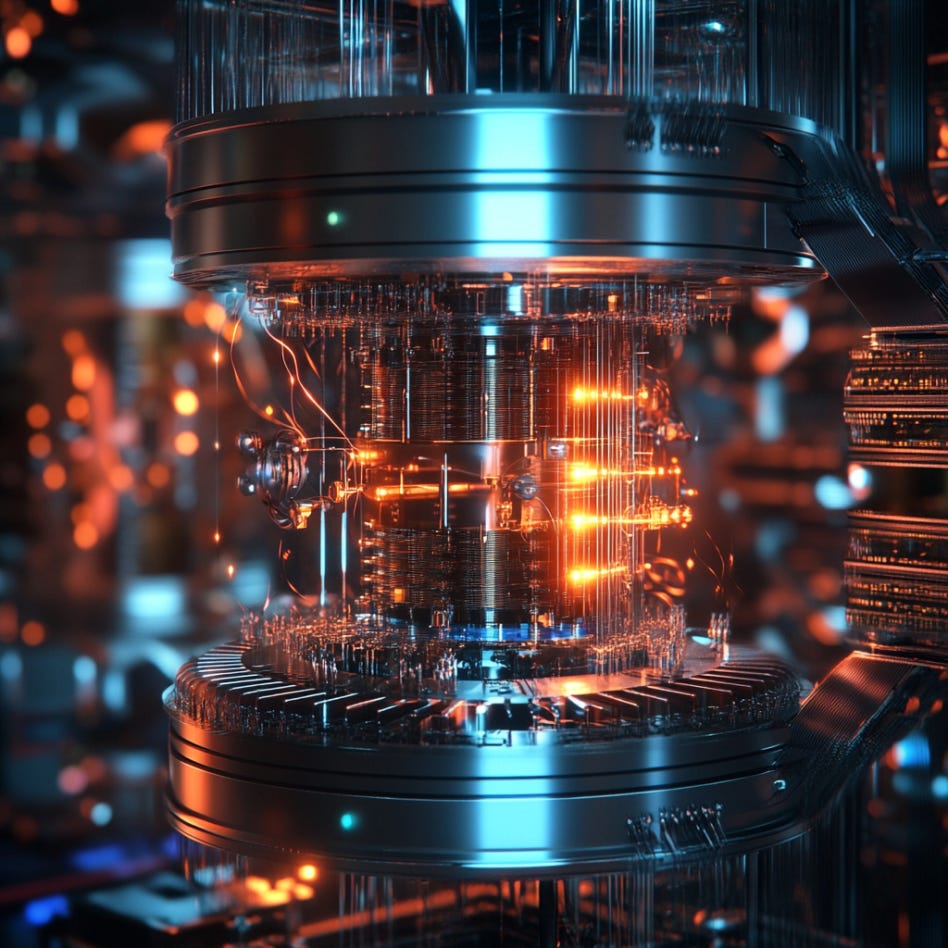Quantum Computing Research (2025): Key Architectures, Companies, Use Cases, Future Potential, Investment Prospects
I analyze the quantum computing market in 2025... and highlight potential use cases for QC tech in the near-term (hybrid with GPUs) & longer-term
Quantum computing, quantum mechanics, quantum mysticism, quantum energy healing, etc. — a little bit of quantum this with a little bit of quantum dat.
The quantum mind virus emerged in 2024-2025 and inevitably causes those infected to FOMO their entire net worth into quantum computing stocks thinking that within a few years they’ll be quantillionaires leveraging quantum spaceships to enter wormholes to align chakras in a 10D spiritual plane defying space-time with toxoplasmosis qubits shat out by Shrodinger’s cat in a multiverse shadow realm.
Once a quantum computer starts humming and subatomic particles bounce around, anything is possible… you’ve hacked the entire universe… you have the quantum Tibetan monk Kundalini astral travel 40 Hz gamma wave awareness and have tapped your full subconscious and unconscious mind… yeah that’s not how any of this works… but that’s what’s in most people’s heads: complete quantum magic.
No joke: I read something on X/Twitter a while back from a lady who has most of her money in quantum computing stocks because she “understands the quantum mind” and “quantum realm” and “vibrational energies”… maybe her quantum strategy is working? Who knows.
In reality, quantum computing isn’t associated with psychic voodoo witchdoctors… but it does have potential to unlock some efficiencies and highly novel use cases in:
Chemistry & advanced materials
Discrete optimization
Cryptography/cybersecurity
Machine Learning/AI
Considering many big tech companies are pouring money into quantum computing R&D (e.g. MSFT, GOOG, AMZN, IBM, et al.), pure-play companies like IONQ are trying to push the field forward as rapidly as possible, and even NVIDIA is looking to integrate quantum computing with GPUs (hybrid computing via CUDA-Q) — it’s reasonable to think that quantum computing will eventually be useful.
As of now in 2025 the use cases for QC are mostly experimental, proof-of-concept, R&D and preliminary testing… nothing major is being done with quantum computing (no matter what those with the quantum mind virus tell you).
I’ve written about why I think quantum computing stocks were/are in a major hype bubble (2024-2025) and pointed out the fact that some companies like QUBT (a former beverage company with <$1M revenue spiked above $1B market cap) had insane stock gains due to automated buying and/or retail mania.
I could be totally wrong wrong… and this would be a good thing because it would mean the field is actually doing something useful. However, I’ve seen nothing but hype so far.
Many have accepted that quantum is guaranteed to be the “next big thing” — without considering that it could get outgunned (or some of its TAM lunch could get eaten) by competing HPC (high-performance computing) hardware & architectures.
Years ago certain types of problems were thought to be ONLY SOLVABLE WITH QUANTUM COMPUTING… turned out that this limited thinking was incorrect (maybe all we really needed was to unlock the quantum mind?).
Only Solvable with Quantum Computing? I Guess Not.
These are a few examples of problems that were thought to be only solvable with QC… sometimes all you need are sufficiently motivated high IQ nerds infused with caffeine and they end up finding workarounds.
1. Recommendation Systems
Quantum Advantage (2010s): Expected quantum speedup via Quantum Singular Value Transformation (QSVT) and Quantum PCA for large-scale recommendation problems.
Classical Breakthrough (2019-2021): Randomized linear algebra and Tensor Factorization achieved near-exponential improvements, rivaling quantum speedups. Neural Collaborative Filtering (NCF) made quantum approaches redundant. (LINK)
2. Principal Component Analysis (PCA)
Quantum Advantage (2010s): Quantum PCA (QPCA) was thought to exponentially speed up eigenvalue extraction for large matrices.
Classical Breakthrough (2018-2022): Randomized SVD, Nyström methods, and Autoencoders provided equivalent or better efficiency without quantum, leveraging Hessian-free optimization.
3. Supervised Clustering
Quantum Advantage (2010s): Quantum K-means and Quantum Support Vector Machines (QSVM) promised exponential speedups for high-dimensional clustering.
Classical Breakthrough (2020-2022): Tree-based search, approximate nearest neighbors (FAISS), and self-supervised learning achieved similar performance at scale, removing the need for quantum.
4. Low-Rank Matrix Inversion
Quantum Advantage (2010s): The HHL algorithm was expected to provide exponential speedup for solving linear systems in finance and physics.
Classical Breakthrough (2017-2022): Randomized low-rank approximations, preconditioned solvers, and machine learning-accelerated methods closed the speed gap, making HHL unnecessary.
5. Semidefinite Programming (SDP)
Quantum Advantage (2010s): Quantum SDP solvers promised faster solutions for optimization and cryptography.
Classical Breakthrough (2022): Sparse interior point methods and data-driven optimizations reduced SDP complexity significantly, making quantum gains negligible.
6. Topological Data Analysis (TDA)
Quantum Advantage (2010s): Quantum homology computation was believed to vastly speed up persistent homology in complex data structures.
Classical Breakthrough (2021): Compressed persistent homology and fast spectral methods enabled practical large-scale TDA on classical hardware.
A combination of software optimizations, architectural changes/refinements, hardware optimizations/refinements, etc. might be highly competitive with certain use cases that are presently thought to require quantum.
IMPORTANT: Even if a problem is cracked with non-quantum approaches, this doesn’t necessarily mean that quantum couldn’t provide a stronger advantage (over the non-quantum approaches). But sometimes problems that people are convinced require quantum — don’t actually… sometimes a eureka moment is all it takes.
I’m not bearish on quantum, but I think it’s important to put things in perspective. We must consider all competing HPC technologies: GPUs, accelerators, neuromorphic, photonic (optical), ASICs, quantum-inspired algorithms, algorithmic optimizations, and hybrids (e.g. quantum-GPUs).
The rate of algorithmic breakthroughs and classical computing technology advancement might render some aspects of quantum less useful or obsolete… but quantum might also be more useful than we think right now… so we shouldn’t be too harsh here.
Anyways, I researched the current state of “quantum computing” in 2025 — and compiled insights… I used multiple AIs to cross-reference/verify information… some info. might be a little off-base, but most should get the big picture.
Much of the info. re: quantum isn’t public and hard to track down outside the U.S. (e.g. in China).
Quantum computing has evolved from niche academic research to a burgeoning industry that has:
Gate-based processors surpassing 100 qubits (Google’s Willow ~105 qubits, IBM’s Osprey 400+ qubits).
Quantum annealers now at 5,000+ qubits (D-Wave), though specialized for optimization.
Substantial government funding via the U.S. National Quantum Initiative, Europe’s Quantum Flagship, and China’s state-backed programs.
A handful of publicly traded pure-play quantum companies (IonQ, D-Wave, Rigetti) seeing modest but growing revenue.
However, scalability, error correction, and classical competition remain critical hurdles. By 2025, we see clear progress but also realize that fully fault-tolerant quantum computing and broad commercial adoption may still be 5–10 years away.
Related: Quantum Computer Bitcoin Hack: Risk Analysis
I. Quantum Computing in 2025 (Overview)
A.) Hardware Milestones & Major Players
IBM
Qubit Counts: Publicly accessible 127-qubit (Eagle) and 433-qubit (Osprey) systems in 2025, with a roadmap to 1,121-qubit Condor soon after.
Ecosystem: The IBM Quantum platform offers cloud-based access for R&D and enterprise pilots, making IBM the largest public quantum-cloud provider.
Focus: Improving error correction via surface codes, building modular architectures for thousands of qubits.
Google
Willow Chip (~105 qubits), emphasizing advanced surface-code error correction.
Quantum Supremacy Legacy: Claimed in 2019 with a 53-qubit chip for a specialized random-circuit task.
Cloud Integration: Google’s quantum hardware is mostly in-house but partially accessible through limited pilots on Google Cloud.
IonQ
Trapped-Ion Approach: ~32 physical qubits with high gate fidelity, effectively “algorithmic qubits” for small-scale tasks.
Public Listing: IonQ’s SPAC in 2021 gave it significant capital, fueling R&D and marketing.
Focus: Near-term quantum chemistry, HPC pilots, and integration with AWS, Azure, Google Cloud.
D-Wave
5,000+ Qubits in a quantum annealing system.
Commercial Adoption: Known for real-world optimization pilots in logistics, finance, manufacturing.
Gate-Model Project: Developing a universal gate-based prototype to remain relevant beyond annealing.
Microsoft
Topological Qubits: Majorana 1 prototype with 8 qubits.
Azure Quantum aggregator service, reselling IonQ, Quantinuum, and other hardware.
High Risk/High Reward: If topological qubits scale, error-correction overhead may drastically drop.
Amazon (Ocelot Chip)
Cat Qubits: Introduced in early 2025 with claims of up to 90% resource reduction for error correction, but still in prototype stage (9 qubits).
Braket Service: Aggregates IonQ, Rigetti, QuEra, etc., with Ocelot potentially integrated in the future.
Strategy: Dual approach of offering cloud-based HPC synergy (Braket) while developing in-house hardware (Ocelot).
Photonic Startups (PsiQuantum, Xanadu)
No large-scale universal device publicly available, but advanced prototypes (e.g., Xanadu’s Borealis).
Photonic qubits operate at room temperature, requiring sophisticated entanglement and cluster-state generation.
B.) Government & Private Funding
US National Quantum Initiative (NQI), EU Quantum Flagship, China’s major state-driven quantum programs have collectively poured billions into academic and corporate R&D.
SPAC-Era Listings: IonQ, Rigetti, D-Wave used SPAC routes for substantial funding, though revenues remain small.
Corporate Labs: IBM, Google, Microsoft, Amazon run in-house research centers, often partnering with top universities (e.g., AWS Center for Quantum Computing at Caltech).
C.) Commercialization Status
Revenue: Typically in the tens of millions of dollars range for companies like D-Wave, IonQ, and IBM’s quantum cloud services.
Pilot Projects: Logistics optimization (D-Wave), quantum chemistry simulations (IonQ, IBM), cryptography research (Quantinuum).
Braket & Azure: Cloud aggregator models (Amazon, Microsoft) allow customers to experiment with multiple hardware backends, focusing on R&D rather than production-scale quantum computing.
D.) Hype vs. Reality
Progress: Doubling qubit counts every few years; some lab experiments show partial error correction.
Limitations: Noise remains high in “NISQ” devices, limiting circuit depth. Large-scale, fault-tolerant quantum is still not commercial.
Commercial Use: Mostly in R&D or pilot mode, with a few tangible success stories (e.g., small optimization wins, quantum chemistry research).
Competition: Classical HPC (GPUs, AI chips) also improves rapidly. Quantum advantage is proven only for contrived tasks or small-scale cases so far.
Related: Satya Nadella Talks Quantum Computing 2025
II. Key Quantum Computing Architectures (2025)
Quantum computers come in diverse hardware forms, each with unique advantages, challenges, and potential markets.
1. Superconducting Gate-Based
Method: Josephson junction qubits cooled to millikelvin temperatures.
Major Players: IBM (Osprey, Condor), Google (Willow), Rigetti, Intel (R&D).
Emphasizes surface-code error correction, large potential qubit counts.
2. Trapped Ions
Method: Ions in electromagnetic traps, controlled by lasers, high gate fidelity.
Major Players: IonQ, Quantinuum.
Excellent for quantum chemistry, but scaling to hundreds/thousands is non-trivial.
3. Quantum Annealing
Method: Specialized flux qubits for Ising-model optimization.
Major Player: D-Wave. Real pilot revenue in scheduling, supply-chain. Not a universal approach.
4. Topological Qubits
Method: Majorana modes for intrinsic error resilience.
Major Player: Microsoft. If it works, error-correction overhead drastically drops. Currently only prototypes.
5. Photonic Qubits
Method: Photons in waveguides or cavities, measurement-based logic.
Major Players: PsiQuantum, Xanadu. Potential for rapid gates, but large overhead for multi-photon entanglement.
6. Cat Qubits
Method: Uses “cat qubits” for bit-flip error suppression, introduced in 2025 with a 9-qubit prototype.
Major Player: Amazon.
Potential 90% reduction in resource overhead for error correction, but still experimental.
7. Neutral Atoms & Silicon Spin
Neutral-atom arrays (Pasqal, QuEra) for analog/digital-analog simulation.
Silicon spin qubits (Intel, Diraq) might leverage CMOS processes but remain early in development.
III. Types of Quantum Computers & Market Analysis (2025)
A.) Superconducting Gate-Based (IBM, Google, Rigetti, Intel)
1. Technical Foundations
Qubit Mechanism: Typically transmon qubits formed by Josephson junctions on superconducting circuits at millikelvin temperatures.
Error Correction: Surface code or related topological codes that require 100s–1000s of physical qubits per logical qubit.
Cryogenics: Dilution refrigerators keep devices near 10–20 millikelvin to maintain coherent states.
2. Scaling & Roadmaps
IBM: 127-qubit (Eagle), 433-qubit (Osprey) in 2025, aiming for >1,000 qubits with Condor. Ultimately envisions modular “quantum-centric supercomputers.”
Google: Willow (~105 qubits), focusing on advanced error-correction demos. Aims for “quantum advantage” in real-world tasks by late 2020s.
Rigetti: Smaller scale (~80 qubits), focusing on hybrid HPC integration.
Intel: R&D stage, investigating both superconducting and spin qubits.
3. Market Potential
Short-Term (2025–2030): $2–5B in HPC cloud usage, pilot enterprise deals for quantum chemistry, optimization, cryptography research. IBM’s quantum cloud is the most accessible, pulling in a large portion of short-term revenue.
Long-Term (2030–2040): $80–120B potential if fault tolerance arrives. Superconducting gate-based systems could dominate if no other approach leapfrogs in error correction or scalability.
Key Players & Strategies
IBM: Focuses on a broad ecosystem (Qiskit, enterprise partnerships) and progressive qubit expansions.
Google: Maintains a research-oriented approach with synergy to AI.
Rigetti: Targets smaller HPC pilots, might face acquisition or niche survival.
Intel: Leverages semiconductor fab expertise but remains behind IBM/Google in demonstration scale.
B.) Trapped Ion Qubits (IonQ, Quantinuum)
1. Technical Foundations
Ions in EM Traps: Typically Ytterbium or Barium ions cooled by lasers, manipulated with highly precise laser pulses.
High Fidelity: Gate errors can be <0.1%, making them ideal for near-term quantum chemistry R&D.
Slower Gate Operations: Microseconds vs. nanoseconds in superconducting, but longer coherence times.
2. Market Potential
Keep reading with a 7-day free trial
Subscribe to ASAP Drew to keep reading this post and get 7 days of free access to the full post archives.






